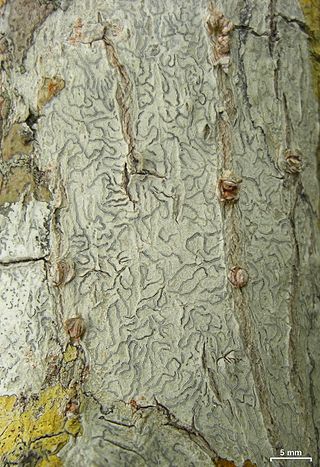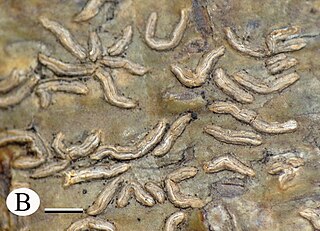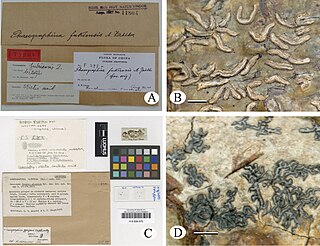
The Graphidaceae are a family of lichen-forming fungi in the order Graphidales. The family contains nearly a hundred genera and more than 2000 species. Although the family has a cosmopolitan distribution, most Graphidaceae species occur in tropical regions, and typically grow on bark.

Sarcographa is a genus of lichen-forming fungi in the family Graphidaceae. It is estimated to contain 37 species. The genus was circumscribed by French botanist Antoine Laurent Apollinaire Fée in 1825.

Platygramme is a genus of lichen-forming fungi in the family Graphidaceae consisting of about 30 species. The genus was circumscribed by Antoine Laurent Apollinaire Fée in 1874.

Phaeographina is a genus of lichen-forming fungi in the family Graphidaceae. The genus was circumscribed by Swiss lichenologist Johannes Müller Argoviensis in 1882.

Graphis is a genus of lichen-forming fungi in the family Graphidaceae.

Fissurina is a genus of lichenized fungi in the family Graphidaceae. It has about 160 species, most of which are found in tropical regions.

Diorygma is a genus of lichen-forming fungi in the family Graphidaceae. The genus was circumscribed by Franz Gerhard Eschweiler in 1824. Species of the genus are widely distributed in tropical and subtropical regions of the world.

Graphis crebra is a species of corticolous lichen in the family Graphidaceae. It has a pantropical distribution. Like other script lichens, it grows on bark and resembles calligraphy. It can be distinguished from several other similar species by the white pruina (powder) on its apothecial discs.

Allographa leptospora is a species of script lichen in the family Graphidaceae. The lichen was first formally described in 1921 by Finnish lichenologist Edvard August Vainio as Graphis leptospora. The type specimen was collected in 1904 by German botanist Carl Curt Hosseus on Doi Suthep, where it was found growing on tree bark. Hosseus sent this and other lichens collected from Thailand to Vainio for identification. Robert Lücking and Klaus Kalb transferred it to the genus Allographa in 2018. In 2016, the lichen was reported from the Sintra Mountains, Portugal, which was its first documented occurrence in Europe.
Halegrapha is a genus of lichen-forming fungi in the family Graphidaceae. It has nine species. The genus was circumscribed in 2011 by Eimy Rivas Plata and Robert Lücking, with Halegrapha chimaera assigned as the type species. The generic name honors American lichenologist Mason Hale.
Allographa uruguayensis is a species of corticolous (bark-dwelling), crustose lichen in the family Graphidaceae. Found in Uruguay, it was formally described as a new species in 2018 by lichenologist Robert Lücking. He had previously informally introduced the species as Graphis uruguayensis in a 2009 publication, but without a proper description. The type specimen was collected in 1968 by Henry Imshaug in Parque Franklin Delano Roosevelt, near Montevideo; here it was found in a planted grove containing Pinus and Eucalyptus. The lichen has a pale yellow-grey thallus, measuring 2–3 cm (0.8–1.2 in) across and 50–70 μm thick, which lacks a prothallus. The ascospores, which number 6 to 8 per ascus, are thick-walled, oblong with between 11 and 17 septa, and measure 45–70 by 6–8 μm. Allographa elongata is somewhat similar in morphology, but is distinguished by differences in the structure of the lirellae, and in ascospore width.

Graphidales is an order of lichen-forming fungi in the class Lecanoromycetes. It contains 6 families, about 81 genera and about 2,228 species. Family Graphidaceae are the largest crustose family within Graphidales order comprising more than 2000 species, which are widely distributed in tropical and subtropical regions of the world.
Graphis lueckingii is a species of script lichen in the family Graphidaceae. Found in southern Brazil, it was fornally described as a new species in 2010 by Manuela Dal-Forno and Sionara Eliasaro. The type specimen was collected by the first author in the Pontal do Paraná, where it was found growing on bark in a forest restinga. The species epithet honours lichenologist Robert Lücking.
Graphis flavovirens is a species of script lichen in the family Graphidaceae. Found in the Andaman Islands, it was formally described as a new species in 2005 by Urmila Makhija and Bharati Adawadkar. The type specimen was collected from Parlobjig. The species epithet "flavovirens", which combines the Latin words for yellow and green, refers to the colour of the thallus. Its ascomata are in the form of conspicuous lirellae: they are long and black, with a branching pattern ranging from simple to radiately and profusely branched; this particular branching pattern is known as the centrifuga-morph. G. flavovirens produces ellipsoidal ascospores that have from 3 to 9 transverse septa and measure 16–42 by 4–8 μm. G. flavovirens contains two lichen products: stictic acid and constictic acid.
Allographa pedunculata is a species of script lichen in the family Graphidaceae, discovered in the Galápagos Islands. The species is characterized by its distinctly stalked lirellae and contains norstictic acid. It is similar to other species in the Graphis nuda species complex but has the longest ascospores in the group.
Fissurina verrucosa is a species of corticolous (bark-dwelling) script lichen in the family Graphidaceae. Found in Karnataka, India, it was formally described as a new species in 2007 by Urmila Makhija and Bharati Adawadkar. This species is characterized by its yellowish-brown and slightly glossy appearance. Its thallus has a cracked, uneven, and verrucose texture.
Graphis khaoyaiensis is a rare species of corticolous (bark-dwelling) script lichen in the family Graphidaceae. Found only in a specific region in Thailand, it closely resembles Graphis dichotoma but can be distinguished by its smaller ascospores and the absence of radiately branched lirellae.
Graphis suzanae is a species of corticolous (bark-dwelling) script lichen in the family Graphidaceae. Described as new to science in 2016, it is found in southern Brazil.

Fissurina insidiosa is a species of corticolous (bark-dwelling), script lichen in the family Graphidaceae. Found in the Southern Hemisphere, it has been recorded from mainland Australia, New Zealand, the Pacific region, the Caribbean, and India.
Allographa anguilliradians is a species of corticolous (bark-dwelling), crustose lichen in the family Graphidaceae. It has been found in Trinidad and Tobago and Central-West Brazil. Its thallus covers an area of 3 to 7 cm in diameter with a slim profile and a variable surface texture, with a distinct metallic pale grey-olive colour without a prothallus. Its reproductive structures, known as lirellae, form a star-like pattern with black, carbonised outer layers and clear, colourless hymenium, while its ascospores are oblong and segmented, reacting violet-blue to iodine-based stains.











